How to Tell the Time in Spanish (Complete Guide)
Ever wonder how to tell the time in Spanish? This is super important because Spanish-speaking cultures often operate on very different schedules than the rest of the world – think taking a long siesta over lunch break and dinner starting at 9 or 10 pm!
So make no assumptions about time in Spanish-speaking countries. Before you do anything, make sure you clearly understand what time things happent. Luckily, I’m here to help you as both your language and cultural guide.
In this article, I’ll teach you the following phrases and more:
- ¿Qué hora es? (“What time is it?”)
- Es/Son… (“It’s … o’clock.”)
- Es la una y media. (“It’s 1:30.”)
- Son las diez de la mañana. (“It’s 10:00 am.”)
- Son las ocho de la noche. (“It’s 8:00 pm.”)
- Como a la una. (“I eat at 1:00.”)
- ¿A qué hora te acuestas? (“What time do you go to bed?”)
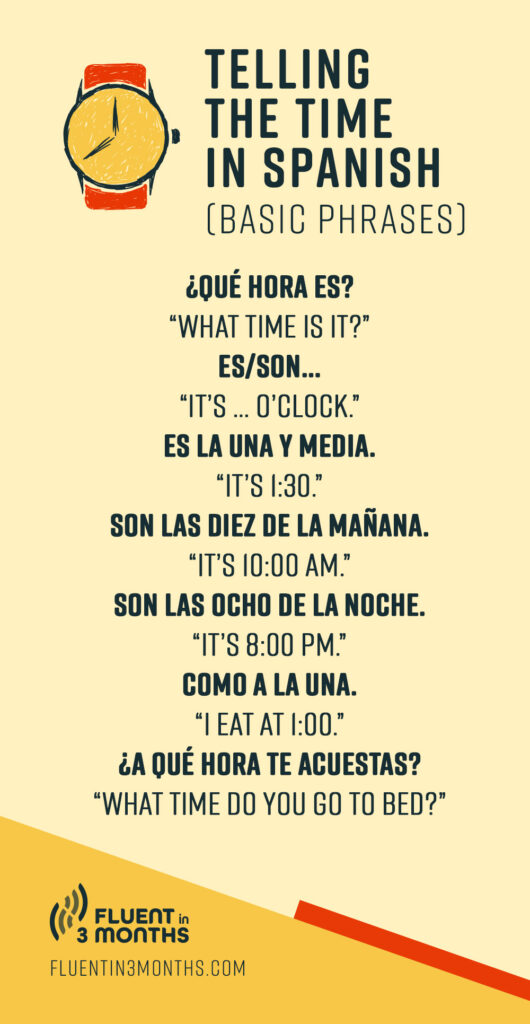
And just a quick bit about me before we get stuck in: I’m a globe-trotting American who has spent most of my adult life overseas. I’m a language teacher and writer, and I’ve spent over 5 years studying Spanish.
Let’s get started!
Table of contents
- The Basics of Telling Time in Spanish: What to Know First
- How to Ask and Answer “What Time Is It?” in Spanish
- Saying When Things Happen in Spanish
- Why, When, and How to Use the 24-Hour Clock in Spanish
- Understanding Ser and the Grammar in Spanish Time
- Spanish Time and Cultural Differences
- Telling Spanish Time Like a Pro!
The Basics of Telling Time in Spanish: What to Know First
First, let’s do a little prep so we can say the time in Spanish like a pro.
If you know how to count from 1 to 59, you’ll be able to master how to say the time in Spanish. (And if you haven’t done so yet, check out our article all about counting in Spanish!) But if you’re not quite there yet, you can say a lot by just learning 1 through 12 for now.
We will also be using the verb “to be” (ser) in Spanish. We have more details about it in our article about Spanish irregular verbs, but what you need to know is this: in the present tense, we’ll use es (“[it] is”) and son (“[they] are”). Why? I’ll explain that next!
How to Ask and Answer “What Time Is It?” in Spanish
The most common way to ask for the time in Spanish is by asking ¿Qué hora es?, which means, “What time is it?” Simple! Now let’s look at how to answer this question.
How to Answer ¿Qué Hora Es?: “What Time Is It?”
Now, to answer “What time is it” in Spanish, we will start our sentence with either es or son. How do you know which one to use?
Easy! If it’s in the one o’clock range, you use the singular es. If it’s two o’clock or later, you use the plural son.
Then we add la (in the case of “one o’clock”) or las (for “two o’clock or later) plus the number.
So in other words:
- “It’s one o’clock” = Es la una.
- “It’s two o’clock” = Son las dos.
- “It’s three o’clock” = Son las tres.
- “It’s four o’clock” = Son las cuatro.
- “It’s five o’clock” = Son las cinco.
- “It’s six o’clock” = Son las seis.
- “It’s seven o’clock” = Son las siete.
- “It’s eight o’clock” = Son las ocho.
- “It’s nine o’clock” = Son las nueve.
- “It’s ten o’clock” = Son las diez.
- “It’s eleven o’clock” = Son las once.
- “It’s twelve o’clock” = Son las doce.
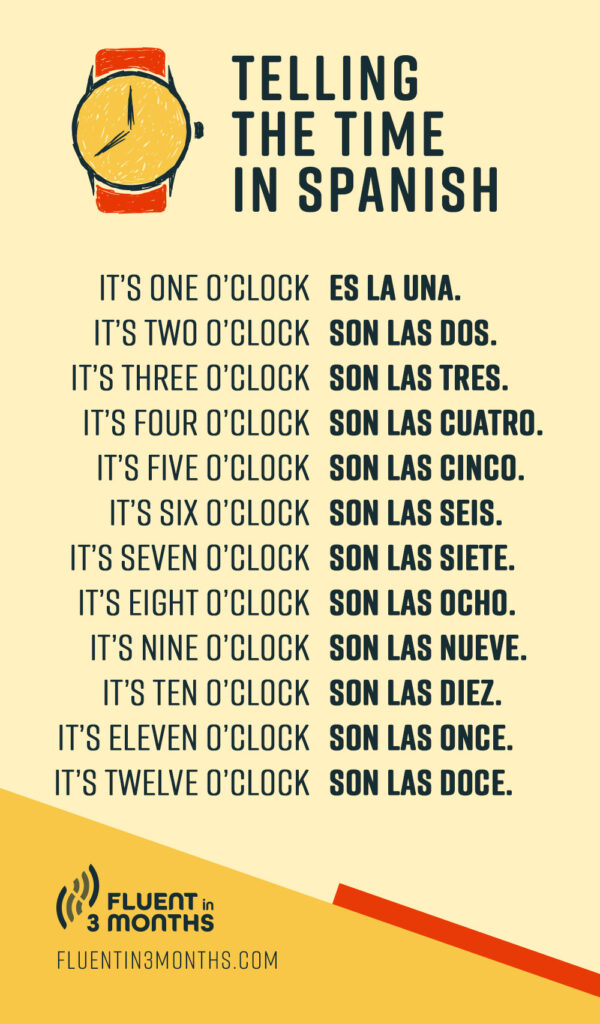
Now, Spanish doesn’t have an “am” and “pm” system. Instead, it specifies the time of day with the following four phrases:
- de la mañana = “in the morning.” This technically is for any time before noon, but is often used for any time before lunch (which might be a bit later).
- de la tarde = “in the afternoon.” Use this for times in the afternoon but before nightfall, approximately between 12:00 pm to 6:00 pm.
- de la noche = “at night.” Use this for most times in the evening or night, approximately between 6:00 pm to 12:00 am. (Note that what constitutes noche vs. tarde may vary across regions and cultural contexts.)
- de la madrugada = “in the middle of the night.” We don’t have this exact expression in English, but it’s for the small hours very late at night or very early in the morning. (Useful if you go partying or clubbing, or else if you want to yell at someone for calling you at 2:00 am!)
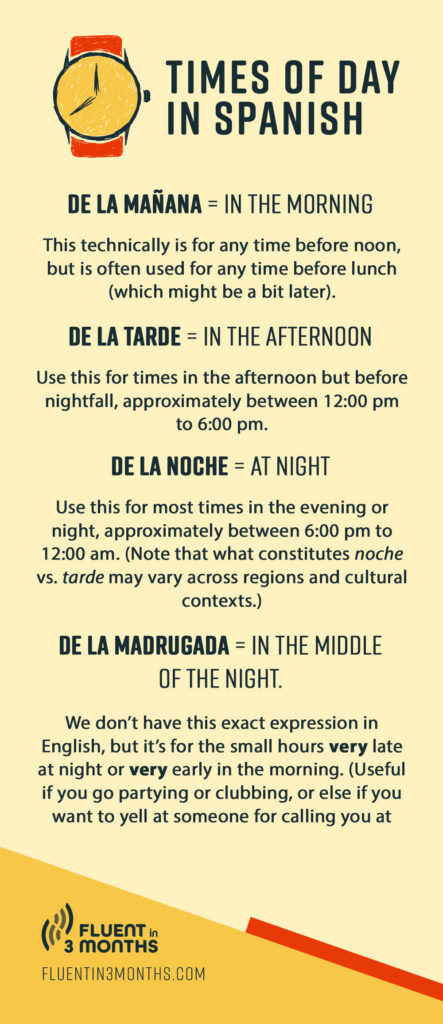
So for example, to say “It’s ten o’clock am,” you would say Son las diez de la mañana. On the other hand, to say “It’s eight o’clock pm,” you would say Son las ocho de la noche. And if your ex calls you to tell you they miss you at one am? ¡Es la una de la madrugada!
By the way, Spanish also has words for “noon” or “midday” (mediodía) and “midnight” (medianoche).
Note that sometimes Spanish uses the 24-hour clock – or if you’re American like me, you might know this as “military time.” So on occasion, you’ll hear or see things like “thirteen o’clock.” This follows the same pattern as the above. We’ll put a pin in this for now but don’t worry. I’ll go into more detail about this in just a bit.
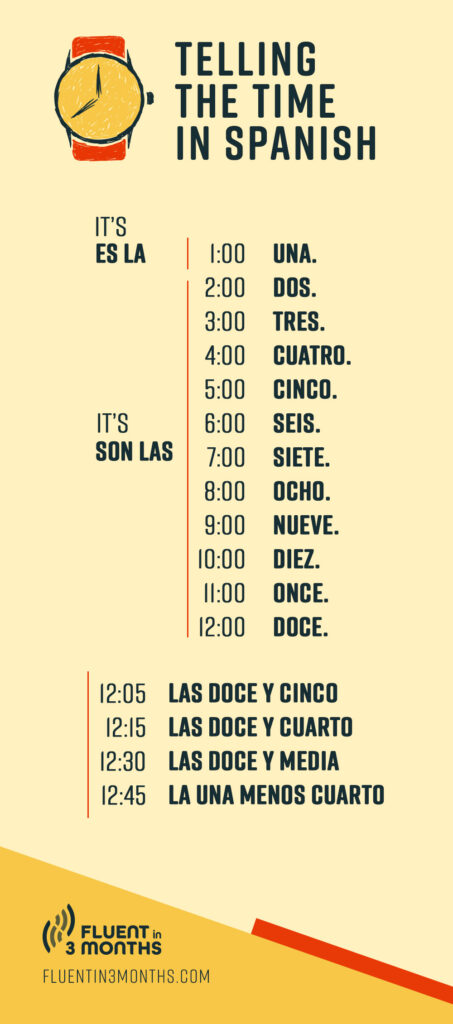
Specific Times and Time Expressions in Spanish
Okay, so we’ve covered the basic hours, but how do you say specific times in Spanish? After all, time isn’t always spot on the hour!
This is easy! To indicate minutes, just add y and the number of minutes.
For example, 6:05 would be las seis y cinco. 12:36 would be las doce y treinta y seis.
Note that some people may replace y (“and”) with con (“with”) or completely omit this word! So 9:10 could be las nueve y diez or las nueve con diez, or las nueve diez. This may depend on the dialect of Spanish being spoken or personal preference. But using y is the most widely understood and used version of this sentence.
Now, when the time hits 15-minute increments, things often change a bit:
- If it’s a “quarter past” the hour (in other words, 15 minutes past), use the phrase y cuarto. This means “and a quarter.” So 4:15 would be las cuatro y cuarto. (I know, it’s a bit of a tongue twister!)
- If it’s “half past” the hour (in other words, 30 minutes past) use the phrase y media. This means “and half.” So 1:30 would be la una y media.
- If it’s “quarter till” the next hour (in other words, 45 minutes past), use the upcoming hour and add menos cuarto (“minus a quarter”). So 6:45 would be las siete menos cuarto (7:00 minus a quarter).
Now, it is possible to use the time y quince (:15), y treinta (:30), and y cuarenta y cinco (__:45). Using y media is especially common, but which system you use may depend on personal and regional references, just like as in English.
Also, you can use menos flexibly with other expressions, too. For example, for 9:55, you can say las diez menos cinco.
By the way, here are a couple more useful phrases to be more specific about the time:
- en punto = “exactly,” “on the dot,” or “sharp” (Son las tres en punto = “It’s 3:00 exactly.”)
- más o menos = “more or less,” “about” (Es la una y cuarto, más o menos = “It’s about 1:15.”)
- y pico = “just after” or “just past” (Son las once y pico = “It’s just after 11:00.”) Note this is a very colloquial phrase.
Saying When Things Happen in Spanish
Okay, so we’ve covered how to read the clock. And so what about when you want to talk about what time certain things happen? For example, how do you say, “I eat at 1:00”?
In this case, just add a (“at”) and the time with the article la or las. So in this sentence, you would say, Como a la una.

Here’s an example of a big lunch you might eat in Spain!
This goes for questions as well. To ask, “What time do you go to bed?”, you would use ¿A qué hora te acuestas? (informal) or ¿A qué hora se acuesta? (formal). This translates literally into “At what time do you go to bed?”
Now, to talk about whether something happens in the am or pm, we can use the same four phrases above. But you’ll often hear Spanish speakers replace de with por. Why? Let me explain.
For example, if you’re on the night shift, to say, “We work at 3:00 am,” you could say either Trabajamos a las tres de la madrugada or Trabajamos a las tres por la madrugada. There is just a subtle difference in meaning. de emphasizes the exact time, while por implies a duration. So the former sentence is exact about the time (probably implying that work starts at 3:00 am), while the latter emphasizes the duration extending into 3:00 am.
Why, When, and How to Use the 24-Hour Clock in Spanish
As I mentioned, sometimes Spanish uses the 24-hour clock, and this is more often used when you write time in Spanish. You’ll see this in written or formal Spanish, such as in official documents, schedules, and timetables.
For example, Spanish might use this method when making announcements on public transportation or declaring event times. This may feel foreign to our readers from the United States but perhaps more familiar to any British or European readers.
Of course in spoken Spanish, we’ll use the 12-hour clock most commonly. But it is still possible to say the time using the 24-hour system. Therefore, it would go a little something like this:
- “It’s thirteen o’clock” = Son las trece. (13:00 = 1:00 pm)
- “It’s fourteen o’clock” = Son las catorce. (14:00 = 2:00 pm)
- “It’s fifteen o’clock” = Son las quince. (15:00 = 3:00 pm)
- “It’s sixteen o’clock” = Son las dieciséis. (16:00 = 4:00 pm)
- “It’s seventeen o’clock” = Son las diecisiete. (17:00 = 5:00 pm)
- “It’s eighteen o’clock” = Son las dieciocho. (18:00 = 6:00 pm)
- “It’s nineteen o’clock” = Son las diecinueve. (19:00 = 7:00 pm)
- “It’s twenty o’clock” = Son las veinte. (20:00 = 8:00 pm)
- “It’s twenty-one o’clock” = Son las veintiuno. (21:00 = 9:00 pm)
- “It’s twenty-two o’clock” = Son las veintidós. (22:00 = 10:00 pm)
- “It’s twenty-three o’clock” = Son las veintitrés. (23:00 = 11:00 pm)
- “It’s twenty-four o’clock” = Son las veinticuatro. (24:00 = 12:00 am)
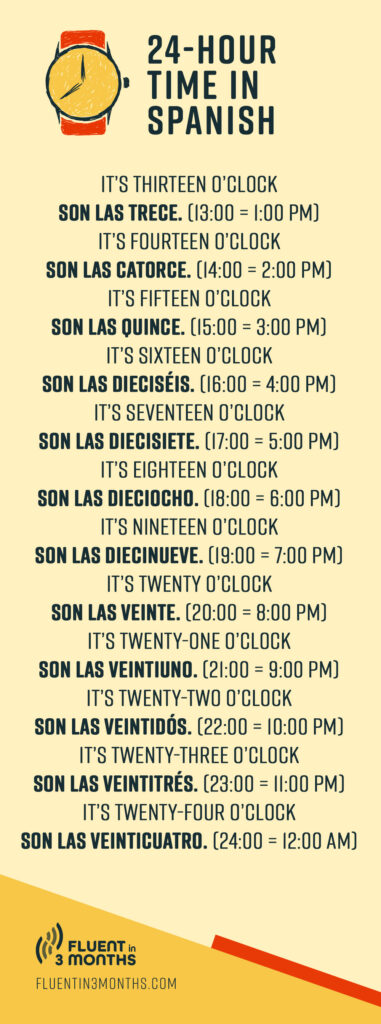
For example, when you look at the timetable to book a train from Madrid to Toledo (a wonderful day trip, by the way!) on Renfe, you’ll notice they use the 24-hour clock!
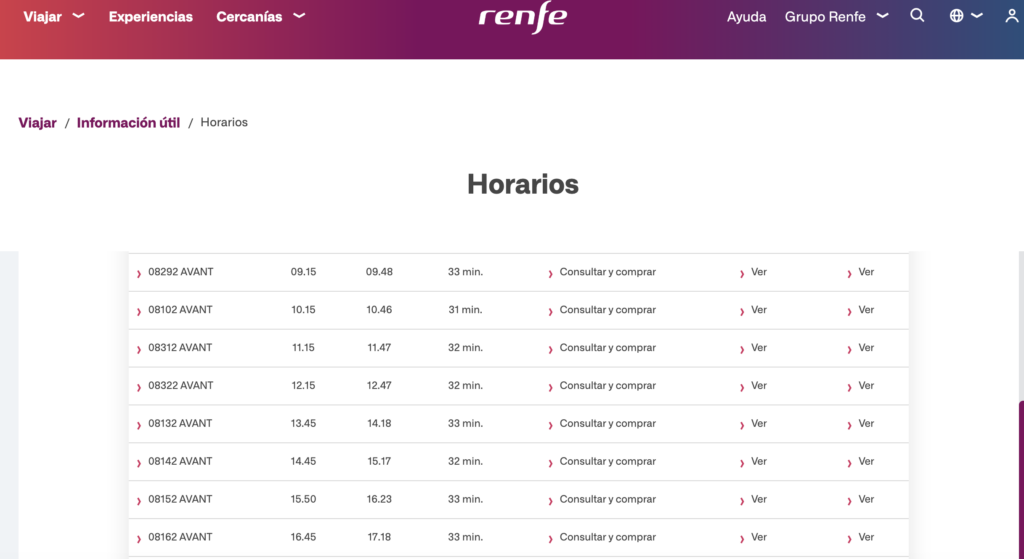
So when you buy your Spanish train ticket, make sure you’re careful. If not, you might accidentally end up at the station thinking you leave at 3:00 instead of 13:00!
Understanding Ser and the Grammar in Spanish Time
There are two things worth noticing about ser when using telling time in Spanish. And understanding these grammar points will push your Spanish comprehension up to the next level!
First, keep in mind that when you ask, “What time is it?” you don’t use the plural form of the verb ser. This is true even if you know it’s two o’clock or later. This is because ¿Qué hora es? literally means “What hour is it?” (It would sound silly to ask “What hours are they?” even in English!)
Second, if you’re at the level where you’re learning about the differences between ser and estar, you may be wondering why we don’t use estar. “Wait a minute, isn’t ser used for permanent things, and estar for temporary things? Why don’t we use estar since the time changes constantly?”
It’s a great question! Even though Spanish doesn’t usually use estar with permanent states, time is the exception. Possibly, Spanish speakers view time as a permanent and continuous state. In any case, it’s a linguistic convention that has been in place for a long time.
But don’t worry too much about this. We have a great acronym (DOCTOR, anyone?) to help you remember this in our article all about when to use ser and estar! If you’re ready for it, definitely check it out!
Spanish Time and Cultural Differences
Hispanic culture is famous for its perception of time compared to many Anglophone cultures! Here are a few key differences, although there might be some variance depending on whether you’re in an urban or rural area.
Punctuality is Somewhat Relaxed
In the US and UK for example, punctuality is valued. Being on time shows respect for the other person’s time. However, in many Spanish-speaking cultures, this doesn’t always hold true. Being “on time” is more flexible. The idea of sticking to planned schedules for utmost management efficiency isn’t as attractive. It’s not uncommon for events and meetings to start later than the scheduled time.
But be careful – this is usually true when people are meeting each other. If you have a train to catch, make sure you’re on time!
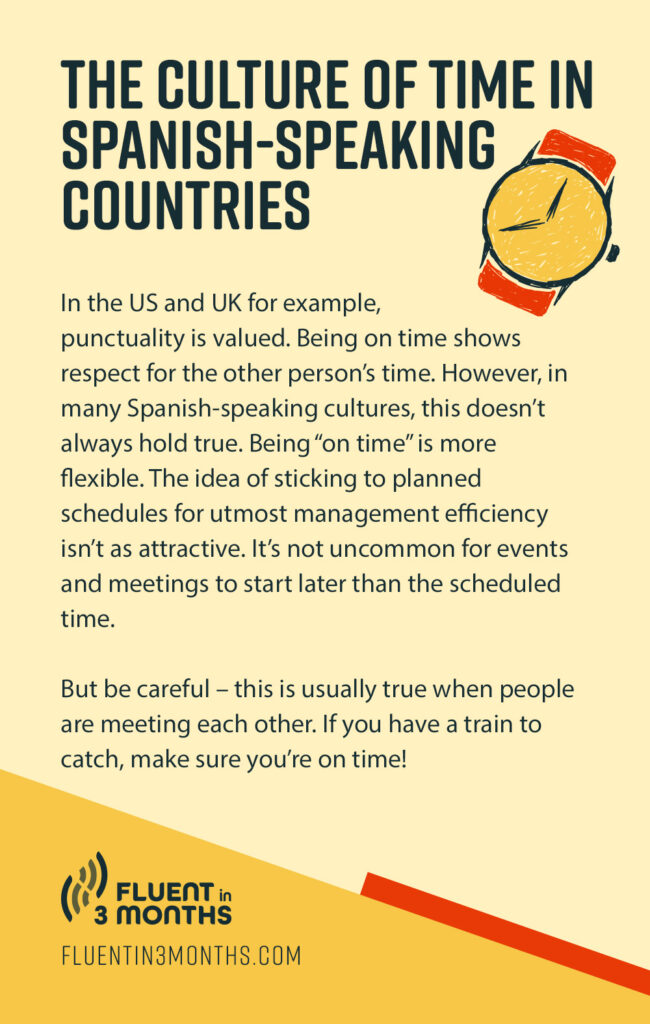
Meal Times Start Later
In many Spanish-speaking countries, meals – especially dinner – often start later than in the US and UK. It’s not uncommon for dinner to start anywhere between 8:00 to 10:00 pm in Hispanic culture! However, lunch is usually the biggest meal in these cultures, so dinner is much lighter than in many English-speaking countries.
I just met someone from Argentina who told me she doesn’t send her kids to bed until midnight – probably because they don’t eat dinner until 10:00 pm!
Lunch is also often relatively late, often starting between 1:00 to 3:00 pm. This is also connected to siesta culture, in which businesses might close for a few hours after lunch. Employees often take long lunches (compared to the 30 or 60 minutes common in US culture).
This can be seen as a blessing or a curse. While taking a couple of hours to digest a long lunch might be great for some people, a Spanish friend I met in Spain felt burdened by this. Since most businesses were also closed at this time, he couldn’t do any errands, and since lunches ran late, the end of working hours did too!
Telling Spanish Time Like a Pro!
Now that you know all the ins and outs of telling time in Spanish, you’ll never get confused again! With just a few common words, you can talk about all sorts of times and make all sorts of plans. So have fun, and hasta luego (see you later)!

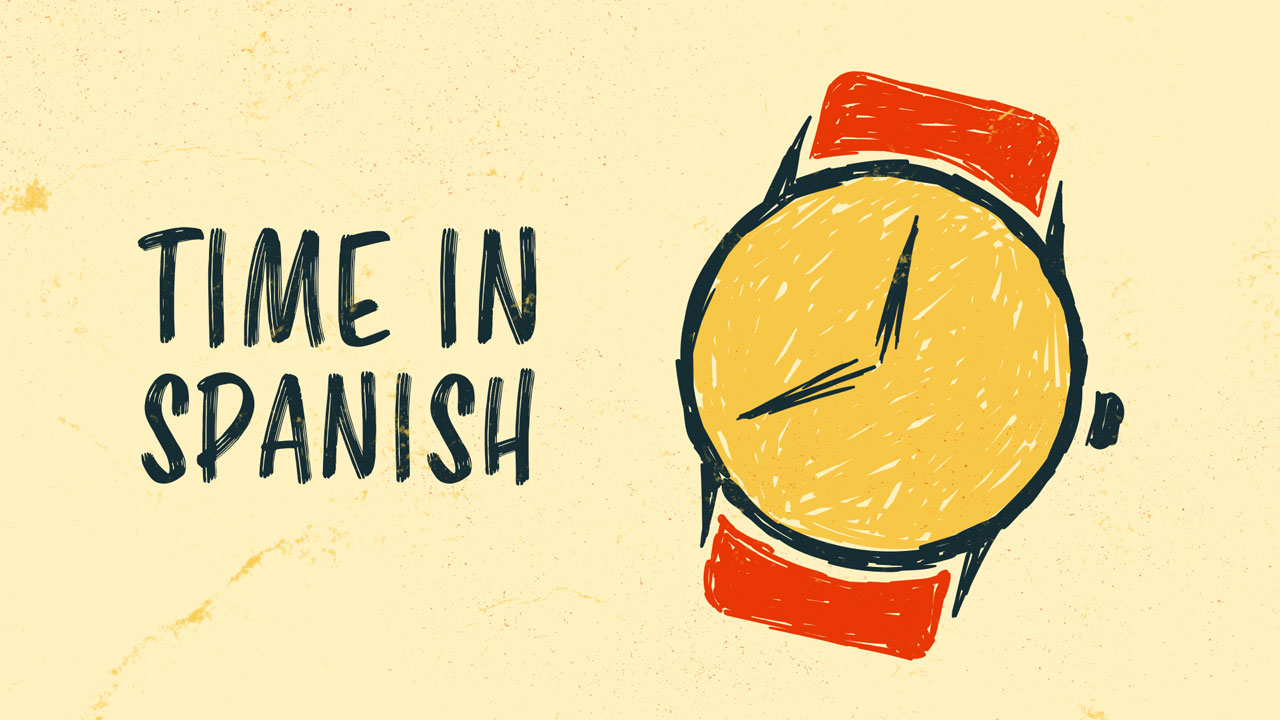

Social